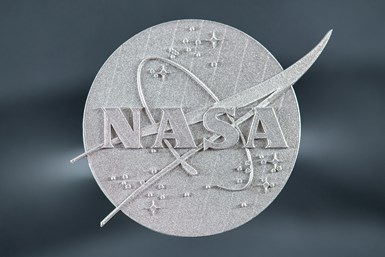3D Systems Verifies Performance of NASA’s GRX-810 Super Alloy
This oxide dispersion-strengthened alloy, developed by NASA, demonstrates exceptional mechanical properties and resistance to extreme temperatures, making it well suited for future use in critical components such as rocket engines, turbine blades and exhaust nozzle components.
Share
Read Next
NASA’s GRX-810 super alloy for laser powder bed fusion has exceptional mechanical properties and resistance to extreme temperatures, making it well suited for aerospace applications. Photo Credit: NASA/Jordan Salkin
3D Systems has successfully verified properties for NASA’s new laser powder bed fusion (LPBF) super alloy, GRX-810. This oxide dispersion-strengthened alloy, developed by the National Aeronautics and Space Administration (NASA), is said to demonstrate exceptional mechanical properties and resistance to extreme temperatures, making it well suited for aerospace applications.
GRX-810 is a potential game changer for the aerospace industry. Through its oxide dispersion strengthening mechanism, the company says the alloy can offer an unparalleled combination of strength, ductility, creep life and heat resistance. These properties make the alloy a good candidate for future use in critical components such as rocket engines, turbine blades and exhaust nozzle components.
Working with material provided by NASA, 3D Systems has successfully processed and tested the elevated temperature mechanical properties of GRX-810 using its Direct Metal Printing (DMP) platform. This verification of properties represents a major milestone, demonstrating the performance of the material across different equipment and processing parameters, and further opening the door for the use of GRX-810 in various aerospace components that require superior performance to traditional nickel-based super alloys.
“The successful verification of the reported NASA GRX-810 properties is a testament to the incredible potential of this new super alloy, not only in its performance but in its capability to be produced repeatably,” says Dr. Michael Shepard, vice president, aerospace and defense segment, 3D Systems. “Our work with this material provided by NASA underscores our commitment to pushing the boundaries of additive manufacturing and enabling the production of next-generation aerospace components. We are thrilled to be part of the early stages of this exciting development and look forward to unlocking new possibilities with GRX-810.”
- Learn about the 3D Systems partnership with Ems-Griltech to advance materials innovation. The companies combined their knowledge to produce DuraForm PAx Natural, a material available for all selective laser sintering platforms.
- Read about 3D Systems’ collaboration with AMT on an SLS solution for efficient additive manufacturing. 3D Systems is partnering with AMT on an industrial-scale selective laser sintering solution that includes the SLS 380, which is designed to enhance customer success and catalyze industries by delivering parts with unprecedented throughput, consistency, performance and yield.
Related Content
-
8 Transformations 3D Printing Is Making Possible
Additive manufacturing changes every space it touches; progress can be tracked by looking for moments of transformation. Here are 8 places where 3D printing is enabling transformative change.
-
Additive Manufacturing in Space: Failing Upward
Not all 3D printed parts destined for space need to adhere to the standards of human space flight. Yet all parts made for space programs require some type of qualification and certification. NASA and The Barnes Global Advisors explore Q&C for these parts.
-
8 Cool Parts From Formnext 2023: The Cool Parts Show #65
New additive manufacturing technologies on display at Formnext were in many cases producing notable end-use components. Here are some of the coolest parts we found at this year’s show.






.png;maxWidth=300;quality=90)







